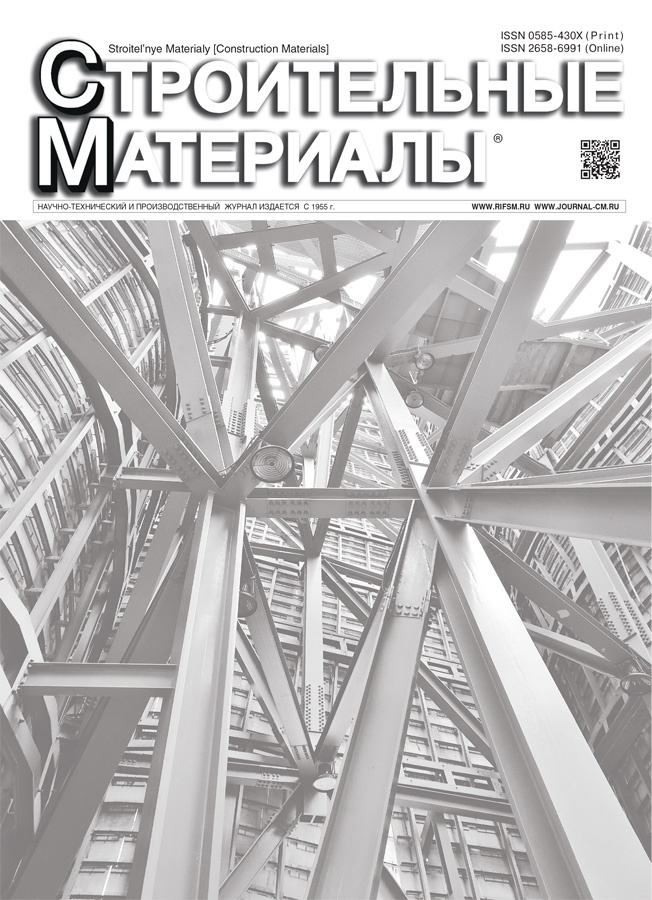On the issue of requirements and tests for ceramic bricks frost resistance
- 作者: Kotlyar V.D.1, Uzhakhov K.M.2, Nebezhko Y.I.1, Zemlyanskaya A.G.1, Orlova M.E.1
-
隶属关系:
- Don State Technical University
- Ingush State University
- 期: 编号 9 (2025)
- 页面: 15-21
- 栏目: Статьи
- URL: https://archivog.com/0585-430X/article/view/693099
- DOI: https://doi.org/10.31659/0585-430X-2025-839-9-15-21
- ID: 693099
如何引用文章
详细
In last years, manufacturers and builders have been paying increasing attention to the ceramic bricks frost resistance, especially front ones. In most cases, this is due to the bricks destruction in the masonry, when responsibility is placed on the brick, since it is in plain sight. This often leads to long-term disputes in search of a culprit, although there may be many reasons for the bricks destruction in the masonry. These are salt corrosion under certain conditions, violations of building norms and regulations during buildings construction, various temperature deformations, etc. Currently, the situation when bricks are tested according to the GOST 530–2012 requirements are frost-resistant, but destroyed in the masonry, has become quite common. Increasingly questions on changing the bricks frost resistance testing methods are being raised. However in order to effectively protect ceramic brick manufacturers from unreasonable claims, fundamental issues must be resolved. Firstly, among the brickmakers” there is uncertainty and constant substitution of concepts between the frost resistance of ceramics as a material and bricks as a product. In this regard GOST 530–2012 makes no distinction (Appendix B). Secondly, there are common uncertainties for wall products (rock products, concrete wall stones) when the products are operated under the same conditions, but the requirements and testing methods differ. Thirdly, taking into account the significantly increased requirements for frost resistance, the development of accelerated frost resistance testing methods is an urgent issue. Fourthly, the issue of the possibility and legality of bricks taken from the masonry testing remains unresolved. There are also other issues that need to be addressed. The authors have identified the existing uncertainties and contradictions on the above issues and propose solutions to them.
全文:
作者简介
V. Kotlyar
Don State Technical University
编辑信件的主要联系方式.
Email: diatomit_kvd@mail.ru
Doctor of Sciences (Engineering), Professor
俄罗斯联邦, 1, Gagarina Square, Rostov-on-Don, 344003K. Uzhakhov
Ingush State University
Email: uzhahov_km@mail.ru
Candidate of Sciences (Engineering), Professor
俄罗斯联邦, 7, I.B. Zyazikov Avenue, Magas, Republic of Ingushetia, 386001Yu. Nebezhko
Don State Technical University
Email: ceramic_nyi@mail.ru
Engineer, Postgraduate Student
俄罗斯联邦, 1, Gagarina Square, Rostov-on-Don, 344003A. Zemlyanskaya
Don State Technical University
Email: azemlyanskaya@donstu.ru
Candidate of Sciences (Engineering), Associate Professor
俄罗斯联邦, 1, Gagarina Square, Rostov-on-Don, 344003M. Orlova
Don State Technical University
Email: marina.nekrasova.96@list.ru
Candidate of Sciences (Engineering), Assistant
俄罗斯联邦, 1, Gagarina Square, Rostov-on-Don, 344003参考
- Salakhov A.M., Salakhova R.A., Ilyicheva O.M. Influence of material structure on ceramic properties. Bulletin of Kazan Technological University. 2010. No. 8, pp. 343–349. (In Russian). EDN: MVNDPP
- Berkman A.S., Mel’nikova I.G. Struktura i morozostoikost’ stenovykh materialov [Structure and frost resistance of wall materials]. Moscow: Gosstroyizdat. 1962. 166 р.
- Gurov N.G., Naumov A.A., Ivanov N.N. Ways to increase frost resistance of semi-dry brick. Stroitel’nye Materialy [Construction Materials]. 2012. No. 3, pp. 40–42. (In Russian). EDN: OYDXCN
- Loxova N.A. Morozostoikie stroitel’nye keramicheskie materialy i izdeliya na osnove kremnezemistogo syr’ya: Monografiya [Frost-resistant building ceramic materials and products based on silica raw materials]. Bratsk: BrSU. 2009. 268 р. EDN: QNEWYZ
- Dolgiy V.P., Abdrakhimov V.Z., Abdrakhimova E.S. Relationship between the porous-capillary structure and frost resistance of ceramic material. Ogneupory i Texnicheskaya Keramika. 2005. No. 4, рр. 20–23. (In Russian). EDN: IGZRHB
- Ivleva I.A., Belikova M.E. Mineralogical composition of clays as one of the fundamental factors of frost resistance of heat-efficient ceramics. Vestnik of the BSTU named after V.G. Shukhov. 2016. No. 8, pр. 185–188. EDN: WHTDQH
- Kotlyar A.V., Teryokhina Yu.V., Kotlyar V.D. On the issue of tests for frost resistance of road clinker bricks. In the collection: Topical issues of modern construction of industrial regions of Russia. Novokuznetsk. SibGIU. 2019, рр. 94–97. (In Russian). EDN: WSVVZS
- Teryokhina Yu.V., Kotlyar A.V., Nebezhko Yu.I., Nebezhko N.I., Kotlyar V.D. On the question of methods for determining the durability of road clinker bricks and concrete paving slabs. In the collection: Durability of building materials, products and structures, dedicated to the 75th anniversary of the honored scientist of the Russian Federation, academician of RAASN, doctor of technical sciences, professor Selyaev Vladimir Pavlovich. Saransk. 2019, рр. 367–374. EDN: ZBNTMR
- Kotlyar V.D., Nebezhko N.I., Teryokhina Yu.V., Kotlyar A.V. On the issue of chemical corrosion and durability of brickwork. Stroitel’nye Materialy [Construction Materials]. 2019. No. 10, рр. 78–84. (In Russian). EDN: XNOCHR. https://doi.org/10.31659/0585-430X-2019-775-10-78-84
- Isterin E.V., Stolboushkin A.Yu. Optical microscopy of ceramic materials based on fly ash of thermal power plants. Stroitel’nye Materialy [Construction Materials]. 2024. No. 9, pp. 16–21. (In Russian). EDN: WDYTMX. https://doi.org/10.31659/0585-430X-2024-828-9-16-21
- Stolboushkin A.Yu., Fomina O.A., Shevchenko V.V., Berdov G.I., Druzhinin M.S., Kambalina I.V. Study of operational properties of ceramic bricks of matrix structure. Stroitel’nye Materialy [Construction Materials]. 2017. No. 9, pp. 9–13. (In Russian). EDN: ZJAMTT
- Shakurova N.V., Doroganov E.A., Bessmertny V.S., Ivleva I.A. Quantitative criteria for assessing frost resistance based on the analysis of hydrodynamic parameters of wall ceramics. Vestnik of the BSTU named after V.G. Shukhov. 2024. No. 11, рр. 81–91. (In Russian). EDN: WYJCWQ. https://doi.org/10.34031/2071-7318-2024-9-11-81-91
- Uzhakhov K.M., Kotlyar A.V., Orlova M.E. Chemical and mineralogical features of mudstones of the Lower Cretaceous of the Republic of Ingushetia as raw materials for the production of building ceramics. Stroitel’nye Materialy [Construction Materials]. 2025. No. 4, pp. 25–32. (In Russian). EDN: EKCTSG. https://doi.org/10.31659/0585-430X-2025-834-4-25-32
- Orlova M.E., Lapunova К.А., Semenova M.Yu. Properties of Verkhnealkunsky deposit mudstones used as raw materials to manufacture clinker tiles. Construction Materials and Products. 2024. Vol. 7. No. 3, pp. 3–7. EDN: LVNLKE. https://doi.org/10.58224/2618-7183-2024-7-3-7
补充文件














